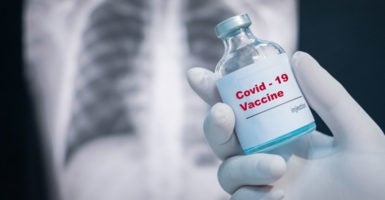Leading biopharmaceutical research and development companies, in the United States and in other countries, are working nonstop to develop a vaccine to combat the COVID-19 pandemic.
In this crisis, government policy must be especially supportive of the research community. In short, public policy must not only ensure that any such vaccine is safe and effective, but also facilitate its rapid development and timely deployment.
For the private sector, collaboration and cooperation among research and manufacturing firms are also critical. In that vein, my own company, Pfizer, released a five-point plan last month.
Pfizer is committed to making the vital tools that we develop widely available to the broader scientific community on an open-source platform.
>>> When can America reopen? The National Coronavirus Recovery Commission, a project of The Heritage Foundation, is gathering America’s top thinkers together to figure that out. Learn more here.
We are also pledging to share data and our findings with researchers in other companies in real time to advance therapies for patients.
Because Pfizer is one of the world’s largest manufacturers of vaccines and therapeutics, we are committed to using any excess manufacturing capacity, including potentially shifting production, to support other research organizations in order to get these lifesaving breakthroughs into the hands of patients as quickly as possible.
For government policy, the good news is that America’s federal regulatory authorities are cooperating with private sector research and manufacturing companies to spur innovation in new therapeutics and vaccines.
Novel approaches to clinical trials, such as telemedicine, and digital remote monitoring, along with a new, streamlined federal regulatory process can expedite research and development.
During a national medical emergency, a strong private and public sector partnership is the key to advancing innovation.
In the United States, that’s now happening.
In this crisis, developing medicine is obviously of paramount importance. But that’s only the critical first step. It’s also necessary to improve patient access to innovative therapies.
One way to encourage rapid and widespread adult vaccination is for the states to review their laws and make sure that community-based pharmacists can administer vaccines.
Roughly 9 out of 10 Americans live within 5 miles of a pharmacy that provides vaccination services to patients without an appointment. When pharmacists are allowed to immunize patients, that not only benefits patients, but it also relieves the pressure on the rest of the health care delivery system.
Moreover, allowing pharmacists to administer vaccines is the lowest-cost alternative for providing this essential public health service.
Community-based pharmacies are excellent means of securing rapid vaccination, particularly in large population centers. They offer extended hours of service compared with other provider sites. They are especially advantageous for younger, healthier adults for whom immunization rates are exceptionally low.
For America’s seniors—those most vulnerable to COVID-19—there’s an additional reason to use pharmacies. A majority of family physicians either aren’t stocking, or are unable to bill for, all available vaccines, especially those reimbursed under Medicare Part D.
In combating COVID-19, collaboration and cooperation will be the key to a successful vaccination program. Pharmaceutical, health care, and trade organizations, including Pfizer, have formed the American Disease Prevention Coalition to help increase vaccination of American adults.
The coalition supports the expansion and harmonization of state laws that would allow pharmacists to immunize the public. Moreover, pharmacists should be allowed to administer all adult vaccines approved by the Food and Drug Administration and recommended by the Advisory Committee on Immunization Practices.
Beyond ensuring patient access, we must also make sure that the medicines are affordable. Private companies (including Pfizer) often provide patient-assistance programs. Fortunately, seniors enrolled in the competitive Medicare Part D prescription-drug program have experienced a decrease (in real dollars) in average out-of-pocket spending over the past decade.
However, while per capita out-of-pocket spending has dropped for the general population, the averages are deceiving. Some seniors still find themselves faced with the burden of unsustainable drug spending.
The Progressive Policy Institute, a Washington-based think tank, found that 2.9% of Americans 65 and over have more than $2,000 of out-of-pocket spending on prescription drugs.
One of the best ways to lower out-of-pocket costs for patients is to ensure that concessions provided to insurers and pharmacy benefit managers go directly to the patients at the point of sale.
Last year, Optum, a pharmacy benefit manager in the UnitedHealth Group, found that when negotiated discounts are passed on as part of their drug-discount program, patients saved an average of $130 per eligible prescription. In addition, prescription drug adherence improved by up to 16%.
Americans are going to win the race for a vaccine and beat this coronavirus. The best way to do that is to maintain a strong public-private sector partnership. That’s not only true in the fight against COVID-19. It will be necessary in the battle against future diseases, epidemics, and pandemics.
The private sector will do the hard work of scientific research. For their part, public officials must champion policies that encourage private sector investment in the development of new and innovative lifesaving treatments while securing the widest possible access and affordability for these therapies for the patients who need them.
































